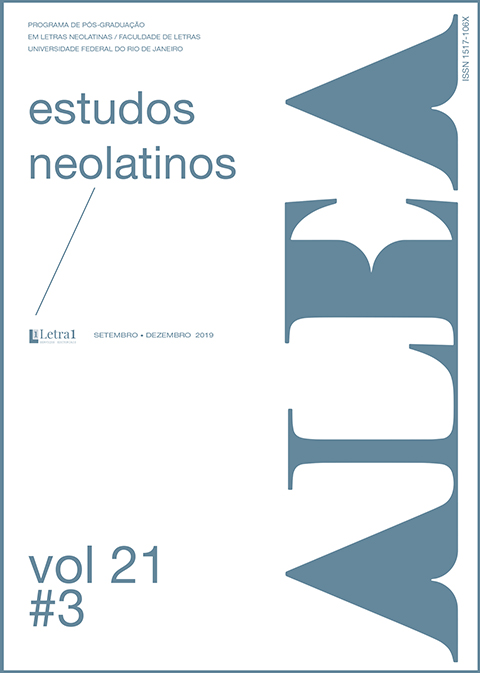O quarto de Ceci: paisagem, natureza-morta e desejo em O Guarani, de José de Alencar
Abstract
Este artigo explora duas linhas contrastivas e complementares de representação da natureza em O guarani (1857), de José de Alencar, que são a paisagem e a natureza-morta, em especial esta última. Gênero que atinge seu clímax no século 17 nos Países Baixos, a natureza-morta passa ao primeiro plano da pintura ao valorizar características como a domesticidade, o apego ao detalhe e, sobretudo, a repressão do desejo, conforme apontam os estudos de Svetlana Alpers, Meyer Schapiro e Jacqueline Labbe. Do ponto de vista formal, o objeto representado necessita ser retirado de seu contexto original e inserido em uma nova teia de relações. Ora, todos esses aspectos estão presentes na descrição do quarto de Ceci no capítulo inicial, onde a atenção às “coisas mínimas” e às “miniaturas”, para retomarmos os termos de Araripe Jr., imprime tamanha força ao desejo que ele se irradia para todo o romance e se torna elemento central para movimentar sua engrenagem narrativa.
Downloads
Riferimenti bibliografici
ALENCAR, José de. O guarani. Obra completa, v. II (romance histórico). Org. M. Cavalcanti Proença. Rio: José Aguilar, 1958, p. 27-406.
ALPERS, Svetlana. The art of describing: Dutch art in the seventeenth century. Chicago, London: The University of Chicago Press, 1984.
ARARIPE JR. “José de Alencar – perfil literário”. In: BOSI, Alfredo (org.), Araripe Jr.: teoria, crítica e história literária. São Paulo: Edusp, 1978, p. 35-96 (“Sob o signo de Alencar”).
BARTHES, Roland. “Le monde-objet”. In: Essais critiques. Paris: Seuil, 1964, p. 19-28.
BLANCHARD, Marc Eli. On still life. Yale French Studies, n. 61, p. 276-298.
BOURNEUF, Roland, OUELLET, Réal. “O espaço”. In: O universo do romance. Trad. José Carlos Seabra Pereira. Coimbra: Almedina, 1976, p. 130-168.
BOSI, Alfredo. “Um mito sacrificial: o indianismo de Alencar”. In: Dialética da colonização. 3a. ed. São Paulo: Companhia das Letras, 1995, p. 176-193.
BROOKS, Peter. “Narrative desire”. In: Reading for the plot: design and intention in narrative. Cambridge/London: Harvard University Press, 1992, p. 37-61.
BRYSON, Norman. Looking at the over looked: four essays on still life painting. Cambridge: Harvard University Press, 1990.
BUTOR, Michel. “O espaço no romance”. In: Repertório. Trad. Leyla Perrone-Moisés. São Paulo: Perspectiva, 1974, p. 39-46.
DUBY, Georges. “A vida privada nas casas aristocráticas da França feudal - Convívio”. In: DUBY, Georges (org.), História da vida privada: da Europa feudal à Renascença, vol. 2.Trad. Maria Lúcia Machado. São Paulo: Companhia das Letras, 2009, p. 52-94.
FREYRE, Gilberto. “Reinterpretando José de Alencar”. In: Vida, forma e cor. Rio de Janeiro: Record, 1987, p. 119-139.
FRIEDLÄNDER, Max. J. Landscape, portrait, still-life: their origin and development. Translated from German by R. F. C. Hull. Oxford: Bruno Cassirer, 1949.
LABBE, Jacqueline M. Romantic visualities: landscape, gender and Romanticism. London: Palgrave Mcmillan, 1998.
LUKÁCS, Georg. “Narrar ou descrever?” In: Ensaios sobre literatura. Tradução de Leandro Konder. Rio de Janeiro: Civilização Brasileira, 1965, p. 43-94.
MCCOUBREY, John W. Studies in French Still-Life painting, theory and criticism: 1660-1860. Dissertation in the Department of Fine Arts, University of Michigan, Ann Arbor, March 1958.
RYAN, Marie-Laure. “Space”. In: The living handbook of narratology. Disponível em: <http://www.lhn.uni-hamburg.de/article/space>. Acessado em 12 de setembro de 2018.
SCHAPIRO, Meyer. A arte moderna: século XIX e XX – ensaios escolhidos. Trad. Luís Roberto Mendes Gonçalves. São Paulo: Edusp, 2010.
SIMMEL, Georg. “Philsophie du paysage”. In: La tragédie de la culture et autres éssais. Traduction S. Comille et P. Ivernel. Paris, Marseille: Rivages, 1988, p. 369-375.
SOUSA, Gabriel Soares de. Tratado descritivo do Brasil em 1587. Francisco Adolpho de Varnhagen (Org.). Rio de Janeiro: Laemmert, 1851.
SÜSSEKIND, Flora. O Brasil não é longe daqui. São Paulo: Companhia das Letras, 2006.
##submission.downloads##
Pubblicato
Fascicolo
Sezione
Licenza
O/A/S AUTOR/A/S confirma/m sua participação em todas as etapas de elaboração do trabalho: 1) Concepção, projeto, pesquisa bibliográfica, análise e interpretação dos dados; 2) Redação e revisão do manuscrito; 3) Aprovação da versão final do manuscrito para publicação; 4) Responsabilidade por todos os aspectos do trabalho e garantia pela exatidão e integridade de qualquer parte da obra. O envio dos trabalhos implica a cessão imediata e sem ônus, por parte de todos os autores, dos direitos de publicação para a revista Alea, a qual é filiada ao sistema CreativeCommons, atribuição CC-BY (https://creativecommons.org/licenses/by/4.0/). Os autores são integralmente responsáveis pelo conteúdo do artigo e continuam a deter todos os direitos autorais para publicações posteriores do mesmo, devendo, se possível, fazer constar a referência à primeira publicação na revista. Alea não se compromete a devolver as contribuições recebidas. Autores de artigos, resenhas ou traduções receberão um exemplar da revista.

